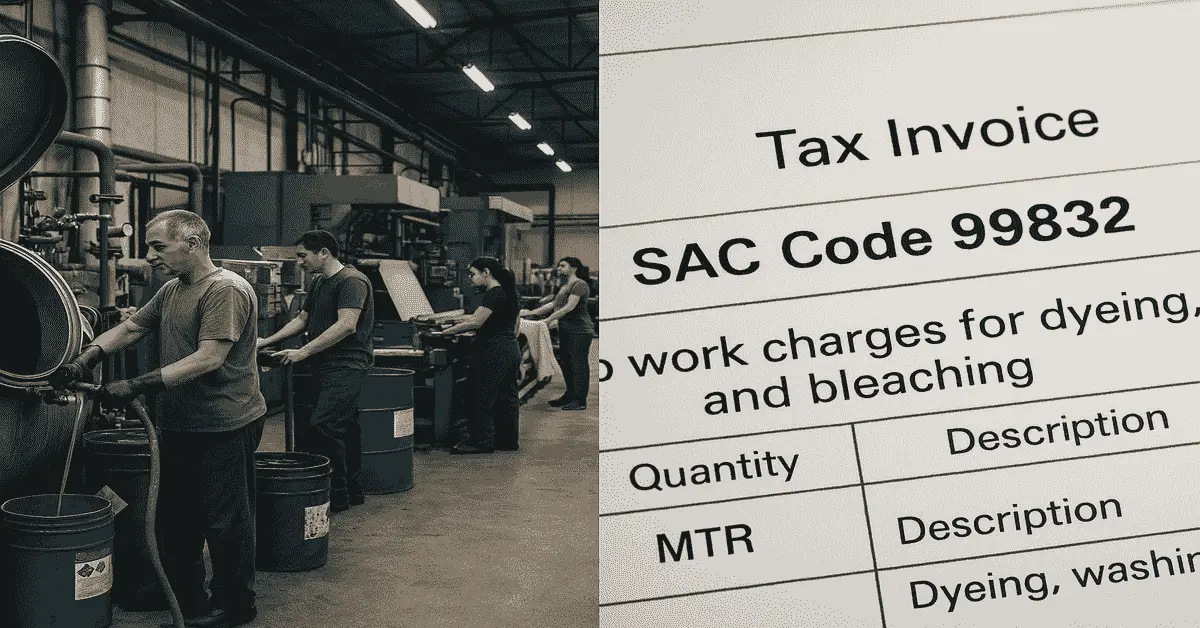
Textile Chemicals HSN Code is a standardized numerical classification system used in international trade to identify and categorize chemicals used in the textile industry for customs and taxation.
Table of Contents
Textile Chemicals HSN Code
Ever felt like decoding international trade regulations is akin to cracking a secret language? Well, in a way, it is! But fret not, because the textile chemicals HSN code system acts as our Rosetta Stone in this global marketplace. This classification method, a universal standard for identifying goods, is pivotal for anyone involved in the buying or selling of textile processing agents. It’s the key that unlocks smooth customs procedures and accurate duty calculations. So, why is understanding your textile chemicals HSN code so darn important? It’s the bedrock of compliant and efficient international commerce. Let’s unravel this system together.
HSN Code & Its Importance
HSN codes are structured in a hierarchical manner. This allows for precise categorization of goods. The complete HSN code consists of eight digits in India. However, the international standard is six digits. Let’s break down the structure:
Chapter (First two digits): These digits represent broad categories of goods. For textile chemicals, you’ll typically find them within specific chapters related to chemical products.
Heading (Next two digits): These further specify the product category within a chapter. Several headings might be relevant to different types of textile chemicals.
Sub-heading (Next two digits): These provide an even more detailed classification of the product within a heading. This is where the distinction between various textile chemicals becomes clearer.
Tariff Items (Last two digits – applicable in India): These eight-digit codes offer the most specific classification and are used for national tariff purposes in India.
For instance, a simplified example (not an actual textile chemical code) might look like this:
| Digit Position | Represents | Example (Illustrative) |
| 1–2 | Chapter | 32 – Dyes and pigments |
| 3–4 | Heading | 04 – Synthetic organic coloring matter |
| 5–6 | Sub-heading | 11 – Disperse dyes |
| 7–8 | Tariff Item | XX – Specific variant (as applicable in India) |
Comprehending this structure is the first step in correctly identifying the textile chemicals HSN code for your products. It’s like understanding the grammar of international trade – essential for clear communication and avoiding misunderstandings.

Types of Textile Chemicals
The textile industry thrives on a spectrum of chemicals, each vital for transforming fibers into finished fabrics. Think of these textile chemicals as the essential ingredients in a recipe. Scouring cleanses, bleaching brightens, dyeing colors, and finishing refines.
Scouring and Washing:
Like prepping a canvas, these steps remove impurities using detergents, wetting agents that aid penetration, and enzymes for a more sustainable approach.
Bleaching:
This process lightens the fabric, preparing it for color. Agents like sodium hypochlorite, sodium chlorite, and hydrogen peroxide are used, with stabilizers preventing unwanted color changes.
Dyeing:
Here, dyes and pigments impart color. Leveling agents ensure evenness, and fixing agents make the color last.
Finishing:
This stage adds the final touches. Softeners enhance feel, anti-creasing agents reduce wrinkles, water repellents offer protection, and flame retardants improve safety.
Auxiliary Chemicals:
These support the main processes. Acids and bases control pH. Salts play various roles, especially in dyeing. Surfactants improve chemical interaction, and solvents help dissolve and disperse substances.
Understanding the textile chemicals HSN code for each category is crucial for trade and compliance in this colorful and multifaceted industry. It’s about knowing the language of global commerce for these essential components.
Textile Chemicals HSN Code
Navigating the world of textile chemicals requires familiarity with their specific Harmonized System Nomenclature codes. These HSN codes are essential for accurate classification in international trade. Let’s break down some key categories and their typical HSN code ranges. Keep in mind that specific codes can be quite detailed, and it’s always best to consult official customs resources for the most precise classification.
Here’s a look at some important textile chemicals and their corresponding HSN code areas:
| Chemical Category | Typical HSN Code Range | Examples | Key Considerations |
| Dyes and Pigments | Chapter 32 | Reactive dyes, Disperse dyes, Azo dyes, Pigments | Chemical composition determines the specific sub-heading. |
| Surface-Active Agents (Surfactants) | 3402 | Detergents, Wetting agents, Emulsifiers | Whether they are organic or preparations influences the exact code. |
| Finishing Agents | 3809 | Softeners, Anti-creasing agents, Water repellents, Flame retardants | Composition and intended use are critical for accurate classification. |
| Auxiliary Chemicals | Often within Chapters 28, 29, 38 | Acids (Acetic, Formic), Bases (Caustic Soda), Salts | The specific chemical nature dictates the relevant chapter and subsequent code. |
| Bleaching Agents | Often within Chapter 28 | Hydrogen Peroxide, Sodium Hypochlorite, Sodium Chlorite | Concentration and form (e.g., aqueous solution) can affect the precise code. |
| Enzymes | 3507 | Amylases, Cellulases, Proteases | Preparations versus unmixed products will have different classifications. |
Think of HSN codes as precise addresses for textile chemicals. For example, 3809 91 90 often covers specific finishing agents and dye carriers. This detail matters because it dictates duties, regulations, and trade statistics. Accurate textile chemicals HSN code usage ensures smooth global operations. When unsure, always consult official classifications – be a chemical code detective!
GST Rates for Textile Chemicals
Under India’s Goods and Services Tax (GST) regime, textile chemicals are classified based on their HSN codes, and consequently, different GST rates apply. These rates are crucial for businesses to understand for accurate tax calculation and compliance. The GST rates for textile processing chemicals generally fall into the following brackets:
GST Rates for Textile Chemicals – At a Glance
5% GST
Applies to some basic inorganic chemicals used in textiles.
12% GST
Covers many surfactants (like detergents, emulsifiers) and certain finishing agents used to treat fabrics.
18% GST
Most common rate for dyes, synthetic organic chemicals, and specialized textile chemicals (like softeners, dye carriers, and leveling agents).
Example: HSN 3809 91 90 – finishing agents used in textiles typically fall here.
Key Points to Remember
HSN Code Accuracy
GST rate depends on the exact 8-digit HSN code – get it right to avoid errors.
Stay Updated
GST rates can change. Always refer to the latest CBIC notifications.
When in Doubt
Consult a tax expert or customs professional to ensure proper classification and avoid penalties.
Think of the HSN code as the key, and the GST rate as the lock it opens. Knowing the right key for your textile chemicals ensures you’re on the right side of the taxman and keeps your business operations running smoothly. Staying updated with the latest GST regulations is like keeping your business navigation system current!
HSN Classification Guide
Know Your Chemicals:
Understand the exact composition and function. Don’t rely on just the trade name.
Consult Official HSN:
Refer to the government’s customs tariff and meticulously review chapters, headings, and sub-headings. Pay attention to descriptions and notes.
Seek Expert Advice:
Don’t hesitate to consult customs brokers or classification specialists for guidance.
Maintain Detailed Records:
Keep thorough documentation of chemical compositions and classification rationale.
Stay Updated:
Regularly check for amendments to HSN classifications.
Cross-reference Internationally:
If trading globally, check classification in other countries.
Think of the textile chemicals HSN code as your product’s global passport. Accurate classification ensures smooth trade.
HSN Code Mistakes to Avoid
| Common Mistake | Common Mistake |
| Trade Name Trap | Classifying textile auxiliaries using only marketing names and overlooking the precise chemical composition, which is crucial for accurate HSN code assignment and compliance. |
| Ignoring Specifics | Selecting a broad HSN code heading instead of identifying and using a more detailed sub-heading that accurately represents the specific textile auxiliary, potentially leading to misclassification and incorrect duty calculations. |
| “Preparation” Pitfalls | Incorrectly classifying formulated textile auxiliaries (mixtures) by primarily considering individual chemical components rather than the final product’s intended application and overall chemical composition. |
| Outdated Info | Utilizing old or unrevised HSN code schedules, which can lead to inaccurate classifications over time due to periodic updates in these codes and regulations. |
| Similar Category Confusion | Mistaking textile chemicals that have alike-sounding functions but possess different underlying chemical properties and intended applications, resulting in the selection of an inappropriate HSN code. |
| Avoiding Experts | Hesitating to seek professional guidance from experienced customs brokers or classification specialists when encountering complex or ambiguous HSN code scenarios, potentially leading to persistent errors and compliance risks. |
Avoid Errors By:
| How to Avoid the Mistake | Description |
| Obtain detailed chemical compositions and technical data from suppliers | Accurate classification starts with knowing the exact chemical makeup and function of the textile auxiliary. Always request detailed specifications. |
| Carefully review the official HSN code explanatory notes and guidelines | Refer to CBIC or WCO-provided notes to ensure you’re selecting the most precise and compliant HSN sub-heading. |
| Implement a system to regularly monitor and update your HSN code database | HSN codes and GST rates change over time. Keeping your classification system updated helps ensure ongoing compliance. |
| Conduct regular training for relevant teams | Equip your procurement, logistics, and compliance teams with up-to-date knowledge on HSN code classification to minimize errors. |
| Establish a relationship with customs brokers or HSN code consultants | For complex or borderline cases, expert advice can prevent costly misclassifications and help navigate regulatory changes with confidence. |
Where to Buy Textile Chemicals
Finding reliable suppliers for HSN-compliant textile chemicals is vital for your business operations in India. Here’s a guide to sourcing effectively:
| Sourcing Tip | Description |
| Directly from Manufacturers | Buying from trusted Indian manufacturers like Sarex, Fineotex, or Nano Tech often ensures better understanding of HSN codes, technical support, and pricing. |
| Reputable Distributors and Suppliers | Choose suppliers with a solid compliance track record who can provide valid HSN documentation for their textile chemicals. |
| Specialized Chemical Suppliers | Suppliers focused on niche areas (like dyes or finishing agents) usually offer more accurate and specialized HSN code knowledge. |
| Check for Certifications | Opt for suppliers with recognized quality certifications (e.g., ISO), which suggest attention to compliance, though not a guarantee of correct HSN codes. |
| Verify HSN Codes Independently | Cross-check the supplier-provided HSN codes using official CBIC portals or consult customs professionals to avoid classification errors. |
| Demand Proper Documentation | Ensure all invoices and shipping documents mention correct eight-digit HSN codes for transparency and GST compliance. |
| Consider Location Benefits | Explore nearby or regional suppliers to reduce logistics costs and simplify communication. |
Key Takeaway:
Many suppliers assert HSN compliance, but thorough verification of provided codes is your responsibility.
Exercising due diligence is crucial to ensure the accuracy of HSN classifications for textile chemicals.
Establishing strong relationships with reputable suppliers who prioritize regulatory adherence offers significant business value.
Consider your chemical suppliers as vital partners in maintaining HSN compliance and smooth operations.

Textile Chemicals Checklist
Dealing with textile chemicals, adhering to HSN codes is just one piece of the puzzle. Ensuring a safe, compliant, and responsible operation requires a broader perspective. Here’s a checklist encompassing crucial aspects:
Safe Chemical Storage & Handling:
Smart Segregation:
Are incompatible textile chemicals strictly separated to prevent hazardous interactions? Think acids away from bases, flammables from oxidizers.
Right Containers:
Are textile chemicals stored in appropriate, undamaged containers clearly designed for their specific nature?
Clear Labels:
Are all containers marked with the chemical name, hazard pictograms, receipt/opening dates, and the relevant HSN code for easy identification and safe handling?
Good Airflow:
Are storage areas, especially for volatile textile chemicals, well-ventilated to maintain a safe working environment?
Secure Storage:
Are hazardous textile chemicals kept under lock and key to prevent unauthorized access?
Spill Preparedness:
Are readily accessible spill kits, tailored to the types of textile chemicals on-site, available along with trained personnel?
Immediate Aid:
Is easily accessible first aid equipment (eyewash, safety shower) available, and are staff trained in basic emergency response for chemical incidents?
Personal Protection First:
Is appropriate PPE (gloves, goggles, respirators) provided and its use enforced for all textile chemical handling activities?
Trained Hands:
Are all employees thoroughly trained on the safe procedures for handling each specific textile chemical they work with?
MSDS on Hand:
Are up-to-date Material Safety Data Sheets (MSDS) readily available for all textile chemicals, and are staff trained to understand them?
Emergency Ready:
Are clear, practiced emergency procedures in place for spills, leaks, fires, and exposure incidents involving textile chemicals?
Ensuring Quality & Performance:
Incoming Checks:
Are raw textile chemicals inspected upon arrival for quality and adherence to specifications?
Product Testing:
Are finished textile products tested to ensure they meet quality standards related to the applied textile chemicals?
Consistent Processes:
Are quality control measures integrated throughout the manufacturing involving textile chemicals?
Record of Quality:
Are detailed records of all quality tests and inspections maintained?
Regulatory Compliance:
Legal Adherence: Are you consistently meeting all local, national, and international regulations for handling textile chemicals?
Systematic Management: Is there a robust system in place for managing the lifecycle of all textile chemicals?
Responsible Disposal: Is textile chemical waste managed and disposed of according to environmental regulations?
Regular Checks: Are internal and external audits conducted to ensure ongoing compliance?
Smart Waste Handling:
Waste Separation: Is textile chemical waste properly segregated for safe and compliant disposal?
Authorized Disposal: Is waste disposed of through licensed and authorized waste management services?
Waste Tracking: Are accurate records kept of all textile chemical waste disposal activities?
Empowering Employees Through Training:
Safe Chemical Handling: Are employees comprehensively trained on safe handling practices for all textile chemicals they use?
Emergency Preparedness: Are employees trained on emergency response for spills, leaks, and other incidents involving textile chemicals?
Compliance Awareness: Are employees knowledgeable about and compliant with all relevant regulations and internal procedures for textile chemicals?
Evaluating Operational Integrity (For Traders & Factories):
Manufacturer Reliability: For sourced textile chemicals, is the manufacturer’s safety and compliance history well-understood?
Adequate Workforce: Are there sufficient trained personnel for the safe handling of textile chemicals?
Production Safety (Factories): Are production processes involving textile chemicals designed and operated with safety as a priority?
Reliable Equipment (Factories): Is equipment used for textile chemicals regularly maintained for safe operation?
Safe Processes (Factories): Are manufacturing lines involving textile chemicals optimized for safety and minimal risk?
Quality Assurance Focus: Are thorough quality checks and inspections conducted throughout the handling of textile chemicals and finished goods?
Management Commitment: Does leadership actively promote and support a culture of safety and compliance in handling textile chemicals?
Safe Environment: Is the overall factory or storage environment designed to facilitate the safe handling of textile chemicals?
By focusing on these key areas, businesses in North Dumdum handling textile chemicals can build a strong foundation for safety, compliance, and responsible operations that goes hand-in-hand with accurate HSN code usage.
Struggling with Textile Chemical Classification?
We’re Here to Help.
Understanding HSN codes and GST rates for textile chemicals can be confusing. But getting it wrong can mean delays, penalties, and compliance issues.
Our experts simplify the process. From identifying the correct HSN codes to clarifying GST slabs and sourcing compliant chemicals in India, we’ve got you covered.
Got a question about a specific textile auxiliary? Let’s solve it together—accurately and efficiently.
We offer:
Expert HSN Code Consultation:
Accurate classification of your textile chemicals to ensure compliance and smooth trade.
GST Rate Guidance:
Clarity on the applicable Goods and Services Tax rates for your specific textile chemicals.
Sourcing Support:
Connections to reliable suppliers of HSN-compliant textile chemicals within India.
Product Information:
Detailed information and technical specifications for a wide range of textile processing chemicals.
Stop feeling uncertain. Reach out to our knowledgeable team today for personalized assistance and product consultation. Let us be your trusted partner in navigating the world of textile chemical classification and ensuring your business operates efficiently and compliantly. Contact us now – we’re ready to help you find the right solutions.
FAQs:
What is the HS code for textile chemicals?
Textile chemicals don’t have one single HS code. They fall under various chapters (e.g., 32 for dyes, 34 for surfactants, 38 for finishing agents) depending on their specific type and function. For instance, HSN code 3809 covers finishing agents and dye carriers used in the textile industry.
What is the HSN code 85414011?
HSN code 85414011 is for solar cells, not assembled.
What is the HSN code 83062990?
HSN code 83062990 is for other statuettes and other ornaments of base metal.
What is the HSN code 42031010?
HSN code 42031010 is for jackets and jerseys, of leather or composition leather.
What is HS code for chemicals?
There isn’t one specific HS code for all chemicals. Chemicals are classified across various chapters (28-39) based on their composition and use.
What is the HSN code for dyes and chemicals?
Dyes typically fall under Chapter 32 of the HSN code. Other chemicals used in the textile industry are classified in different chapters like 28, 29, 34, and 38 based on their specific nature and function. For example, HSN code 3204 covers synthetic organic coloring matter (dyes).

